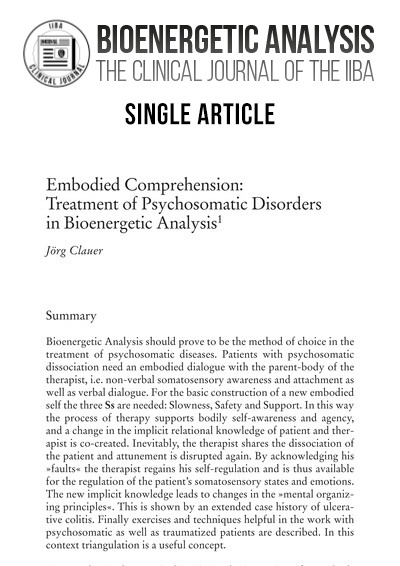Embodied Comprehension: Treatment of Psychosomatic Disorders in Bioenergetic Analysis
DOI:
https://doi.org/10.30820/0743-4804-2007-17-105Ключевые слова:
Psychosomatic dissociation, basic creation of an embodied self, self-efficacy or agency, parent-body, implicit intersubjective knowledge, triangulation, balance disc, rope, teething ringАннотация
Bioenergetic Analysis should prove to be the method of choice in the treatment of psychosomatic diseases. Patients with psychosomatic dissociation need an embodied dialogue with the parent-body of the therapist, i.e. non-verbal somatosensory awareness and attachment as well as verbal dialogue. For the basic construction of a new embodied self the three Ss are needed: Slowness, Safety and Support. In this way the process of therapy supports bodily self-awareness and agency, and a change in the implicit relational knowledge of patient and therapist is co-created. Inevitably, the therapist shares the dissociation of the patient and attunement is disrupted again. By acknowledging his »faults« the therapist regains his self-regulation and is thus available for the regulation of the patient’s somatosensory states and emotions. The new implicit knowledge leads to changes in the »mental organizing principles«. This is shown by an extended case history of ulcerative colitis. Finally exercises and techniques helpful in the work with psychosomatic as well as traumatized patients are described. In this context triangulation is a useful concept.
Загрузки
Как цитировать
Выпуск
Раздел
Лицензия

Это произведение доступно по лицензии Creative Commons «Attribution-NonCommercial-NoDerivatives» («Атрибуция — Некоммерческое использование — Без производных произведений») 4.0 Всемирная.
This work is licensed under the Creative Commons Attribution-NonCommercial-NoDerivatives 4.0 International License (CC BY-NC-ND 4.0). This license allows private use and unmodified distribution, but prohibits editing and commercial use (further information can be found at: https://creativecommons.org/licenses/by-nc-nd/4.0/). The terms of the Creative Commons licence only apply to the original material. The reuse of material from other sources (marked with a reference) such as charts, illustrations, photos and text extracts may require further permission for use from the respective copyrights holder.


